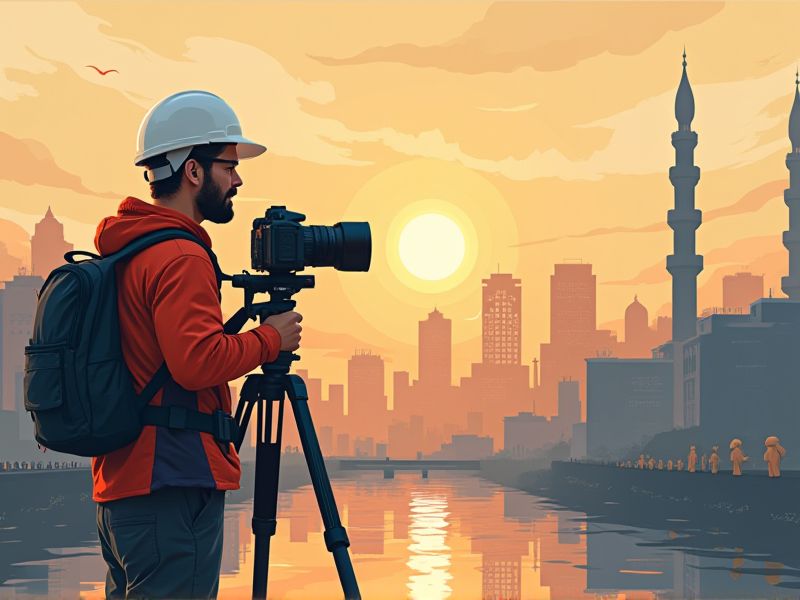
To improve in photography, it's essential to focus on the essence of the craft rather than the tools. As Peter Adams notes, "Photography is not about cameras, gadgets and gizmos. Photography is about photographers," highlighting that a great picture is not made by the camera alone but by the photographer's vision and skill. Practicing and understanding the art of photography, rather than just relying on equipment, is key to capturing meaningful images.
How to Be Better at Photography
Master exposure settings
Mastering exposure settings is vital because precise control over shutter speed, aperture, and ISO directly affects image brightness and clarity. Understanding the relationship between these elements allows you to capture data-driven images that accurately reflect both the scene and your creative vision. Regularly experimenting with various lighting conditions and reviewing your histogram data sharpens your ability to adjust exposure for optimal results. Analyzing the impact of each setting through practice leads to more consistent, high-quality photography that effectively communicates your intent.
Embrace composition techniques
Embracing composition techniques sharpens your ability to guide viewers' eyes, as applying rules like the rule of thirds and symmetry lends balance and clarity to your photographs. Experimenting with framing and leading lines creates a structured narrative within an image, yielding more impactful and memorable visuals. Such methods not only enhance aesthetic appeal but have also been shown to increase viewer engagement and retention rates. Consistently integrating these strategies encourages continual growth in technical skill and creative expression.
Utilize natural and artificial lighting
Mastering both natural and artificial lighting is fundamental for capturing well-balanced images. Early morning or late afternoon sunlight can add warmth and depth, while artificial sources provide controlled illumination for intricate details. Blending ambient and supplemental lighting techniques enhances texture, mood, and clarity in various shooting conditions. Experimenting with multiple light sources allows photographers to refine their craft, leading to more consistently compelling results.
Experiment with depth-of-field
Experimenting with depth-of-field enables greater control over which parts of your image remain in sharp focus, allowing you to isolate key subjects. Adjusting the aperture settings not only affects the amount of light entering the camera but also directly influences the background's level of blur. This technique enhances the storytelling element of your photography by directing the viewer's gaze to the intended focal point. Consistent practice with varying aperture values across different lighting environments strengthens your technical proficiency and creative vision.
Refine manual controls
Mastering manual controls empowers you to take full command of your camera settings under diverse lighting and environmental conditions. Carefully adjusting settings like shutter speed, aperture, and ISO enables you to achieve the precise exposure needed for capturing creative details. Experimenting with these controls provides firsthand data on how subtle changes influence the overall image quality. With regular practice and analysis, refining your manual techniques can significantly elevate both your technical skills and artistic vision in photography.
Hone post-processing skills
Fine-tune your editing workflow by exploring different software tools and experimenting with adjustments like contrast, saturation, and shadow detail. Mastering these adjustments can substantially elevate your photography, allowing you to bring out nuanced details that initial captures might hide. Emphasize learning through online tutorials and hands-on practice, ensuring you understand key concepts like color grading and exposure correction. Consistently revisiting and updating your post-processing techniques based on feedback and data will help you refine a style that resonates with your audience.
Practice different perspectives
Experimenting with various angles sharpens your ability to visualize a scene from multiple dimensions. Embracing unconventional perspectives not only adds a dynamic flair to your photos but also challenges you to think creatively. Adjusting your position relative to the subject can reveal hidden details that traditional viewpoints might overlook. Consistent practice with diverse perspectives will build your technical skills and expand your artistic expression over time.
Analyze successful photographers
Examine the portfolios of established photographers to understand their use of lighting, composition, and color balance. Break down their work by identifying recurring patterns and techniques, such as framing, perspective, and post-processing methods. Compare these insights to your own work, using data-driven assessments like engagement or feedback to pinpoint what resonates most with an audience. Experiment with incorporating these successful elements into your photography while continuously refining your personal style based on both qualitative and quantitative feedback.
Engage in consistent shooting
Engage in consistent shooting to build both technical skills and creative intuition. Consistent practice helps you understand light, composition, and the subtleties of framing, which are essential fundamentals in photography. Regular shooting sessions enable you to experiment with different settings, angles, and subjects, thereby refining your artistic perspective over time. By reviewing your images and welcoming constructive feedback, you can continuously hone your technique and push the boundaries of your creative expression.
Seek constructive feedback
Actively seeking constructive feedback from peers and professionals allows you to identify precise areas for improvement in your photography. Engaging with a variety of viewpoints introduces data-backed insights that optimize composition, lighting, and technique. Utilizing specific critiques to analyze what works and what needs adjustment turns commentary into actionable, measurable improvements. Embracing this iterative process transforms feedback into a powerful tool for reducing errors and enhancing your creative skill set.
Summary
Mastering exposure settings allows photographers to precisely control light, resulting in images with balanced brightness and depth. Embracing composition techniques like the rule of thirds and leading lines creates visually engaging narratives that draw the viewer's attention. Utilizing natural lighting can enhance colors and shadows, while well-planned artificial lighting offers creative control in varied shooting conditions. Together, these elements form a comprehensive approach that elevates both technical skills and artistic vision in photography.
